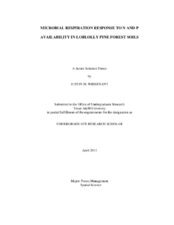| dc.contributor.advisor | Vogel, Jason | |
| dc.creator | Whisenant, Justin | |
| dc.date.accessioned | 2013-06-04T16:10:58Z | |
| dc.date.available | 2013-06-04T16:10:58Z | |
| dc.date.created | 2011-05 | |
| dc.date.issued | 2011-05-05 | |
| dc.date.submitted | May 2011 | |
| dc.identifier.uri | https://hdl.handle.net/1969.1/ETD-TAMU-2011-05-9592 | |
| dc.identifier.uri | https://hdl.handle.net/1969.1/148771 | |
| dc.description.abstract | The complex cycle of nutrients and organic matter in the soil is one of the planet‟s vital processes for maintaining life. Microscopic organisms, or soil microbes, fill a crucial role in this process, as they decompose organic matter and recycle the nutrients back to forms that plants can readily use. Overall, the nutrient cycle is well understood, but certain aspects remain largely unexplored. Specifically, the effect of nutrient availability on the rate that soil microbes decompose organic matter requires further experimental inquiry. Managed pine forests in the Southeastern U.S. represent a good opportunity for studying the effects of nutrient additions because they commonly receive nitrogen and phosphorous fertilization. Nutrient concentrations in forest soils appear to influence the decomposition rates of organic matter in soils; therefore, fertilization of forest soils can change the rate at which CO2 is released from the soil into the atmosphere. This experiment looked at the individual and combined effects of nitrogen and phosphorous additions on soil carbon cycling. We performed laboratory incubations on soil samples from two loblolly pine forests in Florida and measured the CO2 respired by soil microbes using an infrared gas analyzer. Our results indicate that the addition of nitrogen, alone and combined with phosphorous, to forest soils decreases the rate of soil microbial respiration and overall soil CO2 efflux. Phosphorous additions alone also suppress respiration but to a lesser extent. This research further supports the idea that forests will be a key tool for ongoing climate change mitigation because certain management practices may increase forest carbon stores. Continued research in forest soil carbon stores is needed to develop specialized practices that maximize the ability of forests to sequester carbon. | en |
| dc.format.mimetype | application/pdf | |
| dc.subject | p | en |
| dc.subject | n | en |
| dc.subject | phosphorous | en |
| dc.subject | nitrogen | en |
| dc.subject | fertilization | en |
| dc.subject | soil | en |
| dc.subject | forest | en |
| dc.subject | respiration | en |
| dc.subject | microbial | en |
| dc.title | MICROBIAL RESPIRATION RESPONSE TO C, N, AND P AVAILABILITY IN LOBLOLLY PINE FOREST SOILS | en |
| dc.type | Thesis | en |
| thesis.degree.department | Ecosystem Science and Management | en |
| thesis.degree.discipline | Forestry | en |
| thesis.degree.grantor | Honors and Undergraduate Research | en |
| thesis.degree.name | Bachelor of Science | en |
| dc.type.material | text | en |
| dc.date.updated | 2013-06-04T16:10:58Z | |


